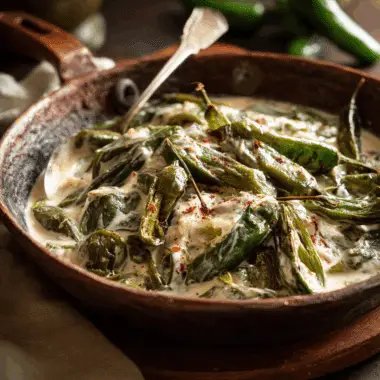Cochinita Pibil is a traditional slow-roasted pork dish from the Yucatán Peninsula in Mexico, renowned for its deep, earthy flavors and bright citrus notes. The pork is marinated in a blend of achiote paste, orange juice, and aromatic spices, then wrapped in banana leaves and cooked until tender and flavorful.
FULL RECIPE
Ingredients
- 3 lbs pork shoulder, cut into large chunks
- 1/2 cup achiote paste
- 1 cup freshly squeezed orange juice
- 1/4 cup freshly squeezed lime juice
- 6 cloves garlic, minced
- 1 tablespoon ground cumin
- 1 tablespoon dried oregano
- 1 tablespoon salt
- 1 teaspoon ground black pepper
- 1/4 teaspoon ground cinnamon
- 1/4 teaspoon ground cloves
- 3 bay leaves
- Banana leaves (optional, for authentic wrapping) or aluminum foil
- 16 small corn tortillas, warmed
- Pickled red onions, for garnish
- Fresh cilantro leaves, for garnish
- Lime wedges, for serving
Directions
- In a large mixing bowl, combine achiote paste, orange juice, lime juice, garlic, cumin, oregano, salt, pepper, cinnamon, and cloves. Whisk until smooth to form the marinade.
- Add the pork chunks to the marinade, making sure each piece is well coated. Cover and refrigerate for at least 6 hours or overnight for best flavor.
- Preheat the oven to 325°F (160°C).
- If using banana leaves, briefly pass them over an open flame or in a hot skillet to soften. Line a large roasting pan with banana leaves or aluminum foil.
- Place the marinated pork and bay leaves into the lined roasting pan. Pour any remaining marinade over the meat. Wrap tightly with the banana leaves or foil.
- Cover the roasting pan with a lid or an additional layer of foil and bake for 3–4 hours, or until the pork is tender and easily pulls apart with a fork.
- Remove from the oven and shred the pork with two forks, mixing it with the pan juices for maximum flavor.
- Serve the shredded pork in warm corn tortillas, topped with pickled red onions, fresh cilantro, and a squeeze of lime juice.
Nutrition Facts
- Calories: 350
- Protein: 28g
- Total Fat: 18g
- Saturated Fat: 6g
- Cholesterol: 90mg
- Carbohydrates: 19g
- Dietary Fiber: 3g
- Sugars: 3g
- Sodium: 640mg
- Potassium: 540mg
Cultural Significance of Cochinita Pibil Tacos
Cochinita Pibil tacos are deeply rooted in the culinary traditions of Mexico’s Yucatán Peninsula. The dish originated with the ancient Maya, who used slow cooking techniques in underground pits known as pib. Over centuries, Spanish influence introduced ingredients like pork and certain spices, creating the fusion we know today. Serving it as tacos is a more modern adaptation, making it convenient for casual dining while preserving the dish’s cultural essence. This blend of history and flavor allows every bite to connect diners with a rich heritage that spans generations.
Flavor Profile and Unique Seasoning
One of the standout aspects of Cochinita Pibil tacos is the depth of flavor created by achiote paste, a spice blend made from annatto seeds, garlic, oregano, and other seasonings. The paste imparts an earthy, peppery taste with subtle bitterness and a brilliant reddish-orange hue. Combined with the brightness of citrus juices and the warmth of spices like cinnamon and cloves, the marinade creates a harmonious balance between tangy, savory, and slightly sweet notes. This complexity makes every taco a multi-layered taste experience.
Nutritional Benefits
While Cochinita Pibil tacos are known for their indulgent flavors, they also offer notable nutritional value. Pork shoulder provides a rich source of protein, essential for muscle repair and energy. The citrus marinade contributes vitamin C, which supports immune health and aids in iron absorption. The use of corn tortillas offers a gluten-free base rich in fiber, supporting digestive health. Garnishes like fresh cilantro and pickled onions add antioxidants and micronutrients, enhancing both the nutritional profile and the vibrancy of the dish.
Popular Variations
Although the classic preparation is cherished, there are many ways to adapt Cochinita Pibil tacos to suit personal tastes and dietary needs. Some cooks substitute pork with chicken for a lighter version, while others use jackfruit or mushrooms to create a satisfying plant-based alternative. Heat lovers often incorporate habanero salsa for an extra kick, and creative chefs may experiment with fusion twists, such as serving the meat in lettuce wraps or topping it with unconventional garnishes like avocado crema. Each variation offers a new dimension while keeping the essence of the dish intact.
Serving Suggestions
Cochinita Pibil tacos are best enjoyed hot, with the pork piled generously onto freshly warmed corn tortillas. Traditional toppings include pickled red onions, which cut through the richness of the meat, and a squeeze of lime to brighten the flavors. For a heartier meal, they can be paired with Mexican rice, black beans, or grilled vegetables. Serving them family-style, with toppings and sides laid out on the table, encourages interaction and customization, making them a favorite for gatherings and celebrations.
Perfect Pairings
The bold and tangy flavors of Cochinita Pibil tacos call for beverages and sides that complement their richness. Refreshing drinks like hibiscus tea (agua de jamaica), horchata, or a crisp lager balance the savory and acidic notes of the dish. For a more elevated pairing, a fruity white wine such as Riesling or a smoky mezcal enhances the complexity of the flavors. Side dishes like elote (Mexican street corn) or a fresh mango salad add contrasting sweetness and texture, creating a balanced dining experience.
Cooking Techniques for Best Results
Achieving tender, flavorful Cochinita Pibil requires slow cooking, allowing the marinade to penetrate deeply into the meat. Traditionally, the pork is wrapped in banana leaves, which help retain moisture and infuse a subtle herbal aroma. For home cooks without access to banana leaves, foil or a covered roasting pan works well. The key is low and slow heat, whether in an oven, slow cooker, or pressure cooker. Shredding the pork and mixing it with its cooking juices ensures every bite is succulent and packed with flavor.
Storage and Reheating Tips
Cochinita Pibil tacos are excellent for meal prep, as the pork’s flavor deepens after a day or two. Store the shredded meat in an airtight container in the refrigerator for up to four days or freeze it for up to three months. To reheat, gently warm the pork in a skillet over medium heat with a splash of broth or water to keep it moist. Tortillas are best warmed separately to preserve their texture. Pickled onions can be stored in the fridge for several weeks, making them a convenient topping for future meals.
Health-Conscious Modifications
For those looking to make Cochinita Pibil tacos lighter, several adjustments can be made without sacrificing taste. Opting for leaner cuts of pork or using chicken breast reduces fat content. Baking or steaming the meat rather than using added oils further lowers calories. Serving the tacos in lettuce leaves or whole-grain tortillas increases fiber and lowers carbohydrate intake. Reducing sodium in the marinade and incorporating extra fresh vegetables as toppings makes the dish more heart-friendly while maintaining its signature vibrancy.
Why Cochinita Pibil Tacos Stand Out
What sets Cochinita Pibil tacos apart from other Mexican tacos is their distinct marinade and cooking method. The combination of earthy achiote, citrus acidity, and aromatic spices creates a flavor that is both robust and refreshing. The use of banana leaves adds a layer of authenticity, while the slow cooking process ensures a melt-in-your-mouth texture. Whether served at a festive gathering or enjoyed as a comforting weeknight meal, these tacos offer a balance of tradition, complexity, and crowd-pleasing appeal.
Conclusion
Cochinita Pibil tacos are more than just a flavorful dish—they are a celebration of history, culture, and culinary craftsmanship. From their origins in the Yucatán to their modern-day adaptations, they have remained a beloved favorite thanks to their unique combination of earthy, tangy, and aromatic flavors. With endless possibilities for customization, thoughtful pairings, and practical storage options, they fit seamlessly into both traditional feasts and contemporary kitchens.








